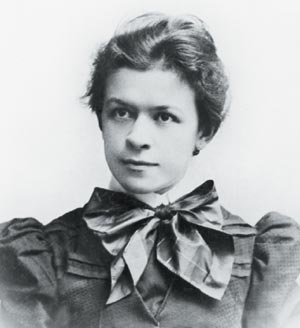Over 70% of people who responded to an online poll think that Einstein’s first wife contributed to his research. But Alberto A Martínez thinks that history cannot be decided by votes
Public-broadcasting television stations across the US recently aired a documentary called Einstein’s Wife. The programme examined the life of Mileva Maric – Einstein’s first wife. There has been speculation about whether she tacitly collaborated on his research into relativity, quantum theory and Brownian motion in his famous papers of 1905.
The documentary is accompanied by an online poll on whether Maric collaborated with Einstein. “Was it really possible for Albert alone to produce all of the phenomenal physics generated during 1905?” the website asks. The site includes material to encourage users to learn about “the scientific accomplishments” of Maric, to compare them with those of Marie Curie, and to speculate on why Maric did not receive any recognition.
This multimedia venture stems from ostensible evidence: allegedly, a physicist once claimed that Maric co-signed the 1905 papers. Early letters suggest a collaboration: one from Albert to Mileva mentions “our work on relative motion”. “Given these facts,” the producers say, “each observer must then decide, on their own, whether or not Einstein robbed Mileva of her due.” As Physics World went to press, 70% of all respondents to the poll believe that Maric had indeed collaborated with Einstein.
Conspiracies and carelessness
An Australian company, Melsa Films, created the documentary. Its producers interviewed various historians of Einstein’s life, including Gerald Holton, Robert Schulmann and John Stachel. They also talked to proponents of Maric. Then they edited these interviews to foster the impression that Einstein and Maric co-created the famous papers.
The facts of the matter, unfortunately, are poorly presented. Many of the claims are misapprehensions, speculations and hearsay. Einstein did not fail his final exams at the ETH Zurich. Neither did he “disregard” Maric’s prospective career. He helped her study and encouraged her repeatedly to complete her degree. Moreover, her existence was no secret and she appears even in early biographies of Einstein.
The documentary and website state “In 1955, a Soviet physicist (now deceased) claimed that he personally saw the original manuscripts and that Mileva’s name appeared as co-author.” They refer to Abram Joffe and reproduce a fragment of a page on which the name “Einstein-Marity” appears in Russian. (Maric used her surname in the form “Marity” when Joffe met her when once seeking Einstein in Switzerland.)
But Joffe made no such claim. What he actually wrote, in an obituary for Einstein in 1955, was “In 1905, three articles appeared in the Annalen der Physik which began three very important branches of 20th-century physics. Those were the theory of Brownian motion, the photon theory of light, and the theory of relativity. The author of these articles, an unknown person at the time, was a bureaucrat at the Patent Office in Bern, Einstein-Marity (Marity – the maiden name of his wife, which by Swiss custom is added to the husband’s family name).”
On this shred of non-evidence, some proponents of Maric have speculated that Joffe subconsciously believed that she was a co-author. This conspiracy theory is buoyed by carelessness. For example, the excerpt shown on television and on the website with the name Einstein-Marity is not even from Joffe’s note, but from that of another writer, Danil Semenovich Danin, who mistakenly paraphrased in 1962 that the papers were “signed” Einstein-Marity. Yet neither writer claimed that Maric had contributed to any papers, nor that they (or anyone) had seen her name on the manuscripts.
Maric’s life included misfortunes. She failed ETH diploma examinations twice. Einstein’s parents antagonized her. Before her marriage she had a baby, apparently given up for adoption. That birth, and then another, greatly weakened Maric. Thus she had reasons to drift away from physics and did not go on to have a career in the field.
Was Maric a victim of intellectual theft? She studied physics at least until 1901. And during those years she worked with Einstein and they shared some projects. The most suggestive bit of evidence is one letter, written in 1901, in which Einstein expressed his hope that the pair would someday complete “our work on relative motion”. Non-specialists might conclude that this statement refers to relativity theory. But it does not. At the time Einstein believed in the existence of the ether. He wanted to devise experiments to test its relative motion – a puzzle that drew the attention of many physicists.
Examining the evidence
So did Maric help Einstein change the direction of his research? All documentary evidence suggests that he did so on his own. He pursued many fruitless attempts to explain the problems of relative motion. After ditching his efforts to detect the ether, he tried to devise a theory in which the speed
of light depends on that of its source. Later, he tried to formulate a theory by modifying that of Hendrik Lorentz. He discussed his evolving ideas not only with Maric, but with friends, professors and co-workers. After 10 years of reflection, he abruptly formulated his special theory of relativity in 1905.
There is just no evidence of any contribution from Maric towards the substantive content of any of Einstein’s papers. Yet the producers of Einstein’s Wife doubt that a single person, Einstein, could have been so prolific. But the hypothesis of a secret and extraordinarily tacit co-worker does not explain the matter. Einstein was just very creative and had an obsessive obstinacy in pursuing and completing his investigations.
Moreover, Maric herself did not claim credit for the work. In late 1906, in a letter to an intimate friend, she commented about Einstein that “the papers he has written are already piling quite high”. As for glib online polls, it is disturbing to think that some people believe that history can be decided by votes. Authority does not decide the past. And neither does ill-informed opinion.




